Demystifying Light Emitting Diode Display Screen Illumination Measurements to Peak Visual Functionality
Demystifying Light Emitting Diode Display Screen Illumination Measurements to Peak Visual Functionality
Blog Article
Light Emitting Diode wall panels are more and more favored across various settings, from homes and commercial spaces as well as communal areas. Such screens are known for their bright and vibrant visuals, that render these ideal to communicating data, ads, as well as engagement. However, understanding the brightness measurements of LED wall screens remains crucial to guaranteeing ideal visual performance. Brightness is measured in units called nits, which indicate the amount of light is emitted from the panel. The higher number of quantity in nits, the more luminous a visual will be. For, example, one screen with 1,000 nits is considerably brighter than a featuring 500 nits, making it better equipped in brightly lit settings.
When choosing a LED wall panel, it is important to take into account which setting where that the screen will be placed. For well-lit lit spaces, like retail environments and open-air locations, higher increased luminosity level is necessary to ensure visibility. Conversely, in darker environments, such as theaters or meeting spaces, lower diminished brightness level may suffice. This is because excessive bright unnecessary brightness in an dark environment may result in viewer discomfort among the audience, causing them more difficult for concentrate with the screen. Thus, comprehending the specific needs for the installation location will aid in choosing the right brightness level for optimal visual experience.
A further crucial element for take into account is the differential proportion of an Light Emitting Diode panel screen. This ratio ratio measures the difference exists between the most luminous light and the dark shade which a panel can create. A greater contrast ratio means that the display can show more clarity as well as depth, thereby enhances overall visual clarity. For example, a panel with an contrast proportion at ten thousand to one will display visuals featuring greater brilliant hues and sharper details compared to one featuring a proportion of 1,000:1. This becomes particularly crucial top article when showing visuals or videos that require high clarity and fine details, including slideshows and promotional content.
Moreover, the mechanism behind LED panel screens plays a crucial role in their illumination as well as total performance. Different types of Light Emitting Diode methods, including OLED and LCD, possess distinct characteristics that impact the way brightness is experienced. Organic Light Emitting Diode screens typically offer better differential as well as darker blacks, thereby can enhance the visual experience in darker environments. Conversely, standard LED panels may prove to be more suitable for bright environments due to their capacity for produce higher amounts in illumination. Understanding these tech-related variances will help consumers to making informed decisions according to their specific needs.
Finally, consistent maintenance and adjustment for Light this website Emitting Diode wall panels may assist maintain optimal illumination and performance over time. Dust and particles may accumulate on a surface, affecting its illumination and sharpness of the display. Regular washing and expert adjustment can ensure the panel panel functions in its optimal, providing consistent image quality. Moreover, some advanced Light Emitting Diode wall panels feature built-in built-in features that allow users for modify illumination levels as well as hue settings based on individual wants. Through taking such steps, users can guarantee that their Light Emitting Diode wall panels deliver an best display efficiency, regardless of the environment in which they are used.